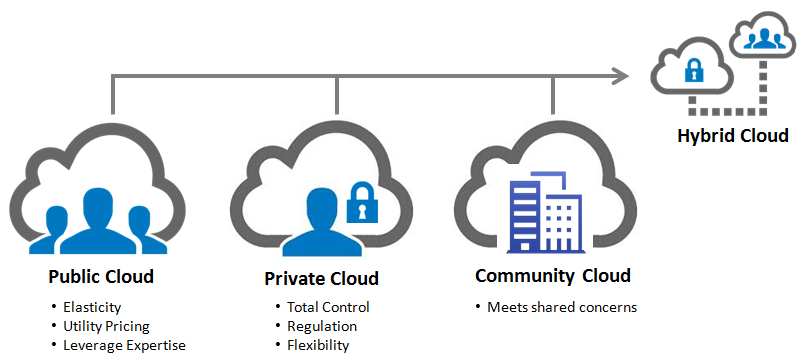
Public, Private or Hybrid Cloud: Which One is Right for You?
Shortly after an organization makes the decision to migrate to the cloud, another big decision must be made: Which cloud model should the business adopt? The public cloud model and private model each have benefits and drawbacks, and several factors must first be weighed before the right decision can be determined.
At SNP Technologies, we take a highly-structured approach to cloud design and development, and our implementation services take into consideration our clients’ current and future business needs before recommending a specific cloud model.
Following is a brief explanation highlighting the differences between public and private cloud offerings as well as some of the key factors we take into consideration before making a recommendation:
Public clouds are hosted services made available over the internet. Organizations that use web servers or application systems where security and compliance requirements are not very rigid normally prefer to use public clouds. For instance, web-based email, data storage, or file transfers over the internet (e.g. FTP), online office applications, and web hosting often use a public cloud.
Key resources (e.g., servers, storage) are shared between multiple users, and the infrastructure, services, and usage policies are often times managed by a cloud service provider.
Some of the key advantages of a public cloud offering include:
- Simple and easy to deploy: Public clouds are easily available as a service over the internet.
- Low initial investment costs: Shared key resources (e.g. servers, storage) enable lower start-up costs, which makes public clouds most appealing to start-ups and small businesses.
- Efficient: IT resources and services are made available immediately, saving time for the company.
- Zero maintenance: Hardware and network infrastructure is maintained by the cloud service provider.
- No contracts: Public clouds typically use a pay-as-you-go pricing model, also known as a utility model.
Some of the disadvantages of a public cloud offering include:
- Lack of control: Clients have zero control over the data infrastructure, which can raise concerns about data privacy and integrity.
- Performance: The network performance depends on the public cloud provider’s internet connectivity, which is largely outside the customer’s control.
- Security concerns: With hardware resource being shared among multiple users, IT security issues and data theft concerns arise.
Private Clouds, which are also known as enterprise clouds, are for organizations that have high security, compliance, and data privacy requirements. Many mission-critical business applications have specific performance, security, and compliance needs, that can only be met by a customized private cloud, which gives you a managed, dedicated, secure and scalable environment. A private cloud needs to be looked at as a long-term investment, which involves a careful selection of the right technology and architecture to ensure optimal performance over a specific period.
Some of the key advantages of a private cloud include:
- Control: Web-based controls allow users to monitor and track system usage and give them a complete view of their IT infrastructure.
- Security & Compliance: Each cloud environment belongs to a single client, which allows for more granular security controls as well as alignment with organizational and industry data governance policies.
- Reliability: Private cloud offerings enable end-to-end managed services capabilities and can meet stricter SLA requirements. Additionally, complementary services such as backup and disaster recovery and granular data retention requirements are oftentimes included.
- Affordable: With the flexibility of private clouds, new workloads can be deployed without incurring extra capital expenses in physical infrastructure.
- Superior Performance: Normally, private clouds are deployed inside the firewall of the organization’s intranet which ensures efficiency and strong network performance.
- Easy Customization: Private cloud hardware and other resources can be easily customized.
Some potential drawbacks of private cloud offerings include:
- Higher Costs: Building an on-premise private cloud data center isn’t cheap. In addition to the initial IT and hardware costs, companies must factor personnel costs and periodic upgrade costs. In the case of outsourced private cloud, operating costs will include per-resource usage and are subject to change at the discretion of the service provider.
- Underutilization: Unlike public clouds where resources are turned on and paid for as needed, private cloud requires companies to purchase resources ahead of time and to predict future needs, which can lead to underutilization.
- Capacity Ceiling: Due to a service provider’s limitations, users could run up against a capacity ceiling regarding how many servers or storage resources the provider can handle.
- Vendor lock-in: This can be a major impediment to private cloud adoption, especially when the hardware and infrastructure is outsourced. This is a service delivery technique where the client company is forced to continue with the same service provider, thus preventing the client from migrating to another vendor.
However, by using a Hybrid approach, companies can maintain control of an internally managed private cloud, keeping the public cloud optional. For instance during peak periods individual applications, or portions of applications can be migrated to the Public Cloud. This will also be beneficial during predictable outages: hurricane warnings, scheduled maintenance windows, rolling brown/blackouts etc
For more information about which cloud computing model suits your business best, Contact SNP Technologies here.




